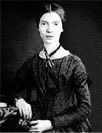Emily Dickinson’s father, Edward Dickinson, a pillar of the community in Amherst, Massachusetts, exerted great influence over his middle child, Emily.
She spent a year at Mount Holyoke Female Seminary. There, her stubborn resistance to conversion during a religious revival marked her as one who did not fear to tread a lonely path.
Dickinson returned from Mount Holyoke to her father’s house and remained there for the rest of her life. Busy about the house and garden, she began to write verse. The narrow boundaries of “woman’s sphere” were deadly limitations for many women.
Somehow Dickinson found within herself the imaginative resources to exceed and shatter such boundaries. Although untaught and virtually unpublished during her lifetime, she became one of the greatest poets in the English language.
Sometimes Dickinson sought encouragement and friendship – from author and reformer Thomas Wentworth Higginson among others. But more and more she withdrew. Alone with her thoughts and her pen, she crafted poetry in experimental form that anticipated modern style. She knew what she had achieved: “I have a horror of death; the dead are so soon forgotten. But when I die, they’ll have to remember me.”
Nearly 1800 poems were discovered by her family after her death.

